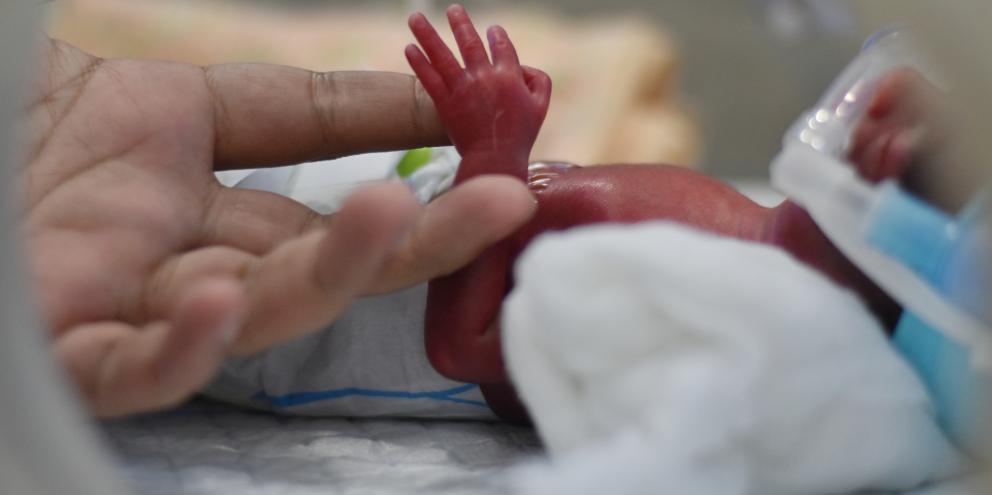
When pediatric or neonate patients are intubated for acute respiratory distress syndrome, too often these vulnerable patients continue to decline when conventional modes of ventilation, such as SIMV and CMV are utilized.
In these cases, the child may be placed on one of two life-saving rescue therapies – either airway pressure release ventilation (APRV) or high-frequency osscillatory ventilation (HFOV). However, there are differing opinions in the medical community as to which rescue therapy is better for these types of patients.
In this article we will take a look at the causes and dangers of acute respiratory distress syndrome (ARDS) in neonate/pediatric patients and how they are currently ventilated. We’ll also discuss the similarities and differences in the use of APRV and HFOV as a rescue therapy for ARDS.
Acute Newborn Respiratory Distress Syndrome
When a baby's lungs are not fully grown, they are unable to produce enough oxygen, leading to breathing difficulties known as Acute Respiratory Distress Syndrome (ARDS) or neonatal respiratory distress syndrome (NRDS). Premature infants are generally most affected. Infant respiratory distress syndrome, hyaline membrane disease and surfactant deficient lung disease are other names for it.
When the baby's lungs do not create enough surfactant, NRDS typically develops due to the important role surfactant play in lung health and function. The lungs are kept inflated and kept from collapsing by this material, which is composed of proteins and lipids1.
Surfactant production in a baby typically starts between weeks 24 and 28 of pregnancy. By week 34, the majority of newborns have enough to breathe normally. The baby's lungs may not contain adequate surfactant if they are born too soon. Occasionally, newborns who are not born prematurely are also impacted by NRDS1.
Between 28 and 32 weeks of pregnancy, around half of all newborns born suffer from NRDS, with the signs of frequently present at birth and progressively worsening over the next few days2.
Identifying NRDS
To identify NRDS and rule out other potential causes, several tests can be utilized.
These consist of2:
- A medical evaluation
- Blood tests to determine the baby’s blood oxygen level and look for infections
- A pulse oximetry test to gauge the baby’s blood’s oxygen content with a sensor affixed to their fingertip, ear, or toe.
- A chest X-ray to check for the lungs’ recognisable hazy appearance in NRDS
Ventilation Modes for the treatment of NRDS
The primary goal of NRDS treatment is to assist the infant in breathing.
Airway Pressure Release Ventilation
APRV, which is a pressure-limited time-cycled ventilatory mode accessible on commercial ventilators with active exhalation valves, was first presented by Downs and Stock in 1987. APRV alternates between the P-high and P-low pressure levels3.
APRV and CPAP are conceptually similar in that they both provide continuous airway pressure, while APRV intermittently lowers airway pressure (to P-low). However, APRV offers better CO2 removal than that provided with CPAP. It can be difficult to tell the difference between APRV and biphasic intermittent positive airway pressure (BIPAP). APRV typically uses is more typically put on extreme inverse ratios to treat refractory hypoxemia than BIPAP. But, if the same inspiratory-expiratory ratio is used, there are almost no differences between the two3.
The possible advantages of APRV are primarily related to spontaneous breathing, and they include: improved patient-ventilator synchrony, which leads to patient improvement. It also provides a more physiological gas distribution to the non-dependent lung areas to improve ventilation/perfusion matching, and offers the possibility of utilizing less sedation and analgesia and an improvement in heart function as a result of lessening patient sedation, as well as lower intrathoracic and right atrial pressures4.
Potential Risks of APRV
Since the majority of the advantages of APRV are linked to spontaneous breathing, it is typically not recommended for patients who need to be deeply sedated and have their neuromuscular blockade activated.
Recent research reveals that inducing paralysis within the first 48 hours of mechanical breathing increases the survival of patients with severe ARDS, even if the use of neuromuscular blocking medications in critically ill patients is still debatable. Later in the clinical phase, when spontaneous breathing may lead to a better distribution of ventilation and aeration to the dependent lung regions, helping to enhance arterial oxygenation, the use of APRV in patients with ARDS may be taken into consideration4.
Some additional risks to consider are a clinician’s potential inexperience and infrequent use of APRV with pediatric patients. Although improvements maybe seen with APRV in susceptible premature neonates, it may be overshadowed by immediate changes in PaCO2, pH, intrathoracic pressures and cerebral blood-flow.4
High-Frequency Oscillatory Ventilation
HFOV is a different type of ventilation that was initially created to treat newborns with respiratory distress syndrome. Active inspiration and expiration are delivered by an oscillating pump in HFOV, which results in minimal pressure fluctuations around a largely constant mean airway pressure (MAP).
It also works to recruit and maintain equal end-expiratory lung volumes, attenuate atlectrauma and enhance oxygenation. Because HFOV delivers very low tidal volume (VT) at high breathing frequencies, the treatment might be seen as the best method for preventing ventilator induced lung injury (VT in ARDS patients (i.e., volutrauma prevention with low VT, cyclic end-expiratory collapse prevention with constant Paw)5.
A recruitment maneuver is frequently advised prior to beginning HFOV in order to reopen collapsing alveoli and enable the relatively high Paw to maintain the recruited lung6.
In addition to other methods, the following may also reduce ventilation/perfusion mismatch6:
- Pendelluft effect, i.e., movement of gas between lung regions with different compliance and time constants
- convective transport of gases, which is the movement of gas into the alveoli as a result of the vacuum left behind by oxygen absorption in the capillaries;
- Longitudinal dispersion, i.e., passage of oxygenated gas from the rapid central jet into the deeper bronchial tree
Multiple gas transport systems enabled by using HFOV, may improve ventilation/perfusion matching and, ultimately, blood oxygenation. 6
The pendelluft effect is particularly significant for lung units with large time constants and for alveoli that the primary HFOV VT would not normally reach. The ventilation of the large or medium airways depends on convective exchange. For the removal of CO2, the longitudinal dispersion is crucial, and molecular diffusion is one of the predominant methods of gas transport close to the alveolar capillary membrane. The prevention of gas trapping, as well as good ventilation and carbon dioxide clearance, are all benefits of active expiration in HFOV6.
Potential risks of HFOV
There are several possible dangers associated with HFOV.
These include6:
- The need for heavy sedation and analgesia in some patients
- A potential substantial decrease in cardiac preload
- Challenging application in hospitals that may have little to no experience with HFOV use
- The possibility that no transport ventilators will be available
- The possibility of Paw loss during circuit disconnections (and consequent de-recruitment)
- The ventilator’s inherent limitations (inculding noisy machines that limit physical examination and the recognition of pneumothorax, endobronchial intubation and endotracheal tube dislodgement)
The Comparative Analysis of APRV and HFOV
The open-lung techniques of HFOV and APRV both adhere to the principles of lung-protective ventilation intended to lessen and prevent VILI. By using a greater mean airway pressure, they can each increase the resting end-expiratory volume and so trigger and maintain alveolar recruitment.6
Yet, despite having similar goals, HFOV and APRV have some key differences. Heavy sedation, analgesia, and neuromuscular blockade are often necessary for HFOV, which is why it is most often recommended for patients who are just beginning to experience severe ARDS since they may benefited from the absence of spontaneous breathing efforts. APRV, on the other hand, is made to permit spontaneous breathing (with all of the benefits mentioned above) and might be less suitable for the initial stages of severe ARDS.6
In order to ensure a lowering in analgesic and sedative agents, enable spontaneous breathing, improve overall endurance to the ventilator and aid in weaning from mechanical ventilation, it is worthwhile to consider using these strategies sequentially. HFOV in the the beginning of the disease, when patients must be deeply sedated, followed by APRV as treatment progresses.6
Conclusion
The bottom line is that APRV and HFOV are both efficient strategies for the treatment of ARDS in newborn and pediatric patients. While there is an ongoing debate as to which is best utilized, both show clear benefits and may be offer better support, depending on the timing of their use.
References
- Hua, M. (2019). Research Progress of Neonatal Acute Respiratory Distress Syndrome. Biomedical Journal Of Scientific &Amp; Technical Research, 22(5). https://doi.org/10.26717/bjstr.2019.22.003820
- Rotta, A., & Piva, J. (2015). Pediatric Acute Respiratory Distress Syndrome. Pediatric Critical Care Medicine, 16(5), 483-484. https://doi.org/10.1097/pcc.0000000000000359
- Demirkol, D., Karabocuoglu, M., Citak, A., Ucsel, R., & Uzel, N. (2008). Airway pressure release ventilation: an alternative ventilation mode for pediatric acute respiratory distress syndrome. Critical Care, 12(Suppl 2), P301. https://doi.org/10.1186/cc6522
- Gupta, S., Joshi, V., Joshi, P., Monkman, S., Vallaincourt, K., & Choong, K. (2013). Airway Pressure Release Ventilation: A Neonatal Case Series and Review of Current Pediatric Practice. Canadian Respiratory Journal, 20(5), e86-e91. https://doi.org/10.1155/2013/734729
- Jayashree, M., & Vishwa, C. (2020). HFOV in Pediatric ARDS: Viable or Vestigial?. The Indian Journal Of Pediatrics, 87(3), 171-172. https://doi.org/10.1007/s12098-020-03215-0
- Facchin, F., & Fan, E. (2015). Airway pressure release ventilation and high-frequency oscillatory ventilation: Potential strategies to treat severe hypoxemia and prevent ventilator-induced lung injury. Respiratory Care, 60(10), 1509–1521. https://doi.org/10.4187/respcare.04255
© 2023 GE HealthCare
GE is a trademark of General Electric Company used under trademark license. Reproduction in any form is forbidden without prior written permission from GE HealthCare. Nothing in this material should be used to diagnose or treat any disease or condition. Readers must consult a healthcare professional.
JB25092XX








